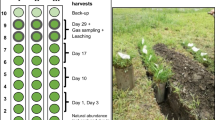Abstract
Cereal-legume mixtures are frequently the best management decision for forage production instead of growing crops in pure stands. Nitrogen fertilization of cereal-legume mixtures is questionable since combined nitrogen could depress N2 fixation by legumes. The objectives of this study were (1) to examine the effect of N fertilization on N2 fixation by vetch and field peas in pure and in mixed stands with oats, and (2) to examine if there is any transfer of N from legumes to associated cereals. The field experiment was conducted for two growing seasons. The treatments were pure stands of vetch, pea and oats, and the mixtures of the two legumes with oats at the seeding ratios 90:10 and 75:25, fertilized with labelled15N at the rates of 15 and 90 kg N ha−1.
Nitrogen fertilization of 90 kg N ha−1 suppressed N2 fixation in both legumes grown in pure and in mixed stands. Crops grown in mixtures in many instances had lower atom %15N excess. Whether this was due to high N2 fixation in the case of legume and transfer in the case of oat or the differences were due to practical problems of the15N technique is not clearly shown by the results, so based on the literature the aspect is discussed as well as the precautions which should be considered in using the15N technique in such studies.
Similar content being viewed by others

References
Allos H F and Bartholomew W V 1959 Replacement of symbiotic fixation by available nitrogen. Soil Sci. 87, 61–66.
Broadbent F E, Nakashima T and Chang Grace Y 1982 Estimation of nitrogen fixation by isotope dilution in field and greenhouse experiments. Agron. J. 74, 625–628.
Chapman S R and Carter L P 1976 Crop Production Principles and Practices. W H Freeman and Co., San Francisco, 512 p.
Dommergues Y R 1978 The plan-microorganism system. p. 1–37. Interactions Between Non-Pathogenic Soil Microorganisms and Plants. Eds. Y R Dommergues and S V Krupa. Elsevier Sci. Publ. Co. New York.
Gibson A H 1971 Factors in the physical and biological environment affecting nodulation and nitrogen fixation by legumes. Plant and Soil, Spec. Vol. 139–152.
Goodman P J and Collison M 1986 Effect of three clover varieties on growth15N uptake and fixation by ryegrass/white clover mixtures at three sites in Wales. Grass Forage Sci. 41, 191–198.
Hadjichristodoulou A 1973 Production of forage cereals, legumes and their mixtures under rainfed conditions in Cyprus. Technical Bulletin No. 14, 18 pp. Cyprus Agricultural Research Institute, Nicosia.
Hardarson G, Zapata F and Danso S K A 1984 Effect of plant genotype and nitrogen fertilizer on symbiotic nitrogen fixation by soybean cultivars. Plant and Soil 82, 397–405.
Hauck R D 1973. Nitrogen tracers in nitrogen cycle studies — past use and future needs. J. Environ. Qual. 2, 317–327.
Legg J O and Sloger C 1976 A tracer method for determining symbiotic nitrogen-fixation in field studies.In Proceedings of the Second International Conference on Stable Isotopes. Eds. E R Klein and P P Klein, pp 661–666. Oak Brook, Illinois.
Miller Jr. Jc., Scott J S, Zary K W and O’Hair S K 1982. The influence of available nitrate levels on nitrogen fixation in three cultivars of cowpea. Agron. J. 74, 14–18.
Morris, D R, Weaver R W, Smith G R and Rouquette F M 1986 Competition for nitrogen-15 depleted ammonium nitrate between arrowleaf clover and annual ryegrass sown into bermudagrass sod. Agron. J. 78, 1023–1030.
Osman A E and Nersoyan N 1986 Effect of the proportion of species on the yield and quality of forage mixtures, and on the yield of barley in the following year. Expl. Agric. 22, 345–351.
Osman A E and Osman A M 1982 Performance of mixtures of cereal and legume forages under irrigation in the Sudan. J. Agric. Sci. Camb. 98, 17–21.
Papastylianou I 1987 Amount of nitrogen fixed by forage, pasture and grain legumes in Cyprus, estimated by the A-value and a modified difference method. Plant and Soil 104, 23–29.
Papastylianou I and Samios Th 1987 Comparison of rotation in which barley for grain follows woollypod vetch or forage barley for grain follows woollypod vetch or forage barley. J. Agric. Sci. Camb. 108, 609–615.
Postgate J R 1982 The Fundamentals of Nitrogen Fixation. 1st ed. Cambridge University Press, New York.
Rennie R J 1979 Comparison of15N-aided methods for determining symbiotic dinitrogen fixation. Rev. Ecol. Biol. Sol. 16, 455–463.
Trenbarth B R 1974 Biomass production of mixtures. Adv. Agron. 26, 177–210.
Vallis I, Henzel E F and Evans T R 1977 Uptake of soil nitrogen by legumes in mixed swards. Aust. J. Agric. Res. 28, 413–425.
Witty J F 1983 Estimating N2-fixation in the field using15N-labelled fertilizer, some problems and solutions. Soil. Biol. Biochem. 15, 631–639.
Witty J F and Ritz K 1984 Slow-release15N fertilizer formulations to measure N2-fixation by isotope dilution. Soil Biol. Biochem. 16, 657–661.
Author information
Authors and Affiliations
Rights and permissions
About this article
Cite this article
Papastylianou, I. The15N methodology in estimating N2 fixation by vetch and pea grown in pure stand or in mixtures with oat. Plant Soil 107, 183–188 (1988). https://doi.org/10.1007/BF02370545
Received:
Revised:
Issue Date:
DOI: https://doi.org/10.1007/BF02370545



